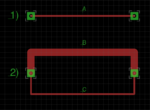juz_ad
Full Member level 2
Apologies if I'm way off the mark here - trying to understand some PCB heat issues...

1) I understand that if a given trace width is too thin (A) to dissipate the amount of current/heat it needs to carry - it will get hot.
2) If the trace took two paths - one (B) with a width that would adequately dissipate the required heat for that trace and one (C) that was still too thin - would trace (B) compensate at all for the temperature of trace (C) - or would trace (C) still get just as hot?
I understand this is a really basic example and there's load of other real-world variables - hope the question makes sense.
Thanks,
/ J

1) I understand that if a given trace width is too thin (A) to dissipate the amount of current/heat it needs to carry - it will get hot.
2) If the trace took two paths - one (B) with a width that would adequately dissipate the required heat for that trace and one (C) that was still too thin - would trace (B) compensate at all for the temperature of trace (C) - or would trace (C) still get just as hot?
I understand this is a really basic example and there's load of other real-world variables - hope the question makes sense.
Thanks,
/ J